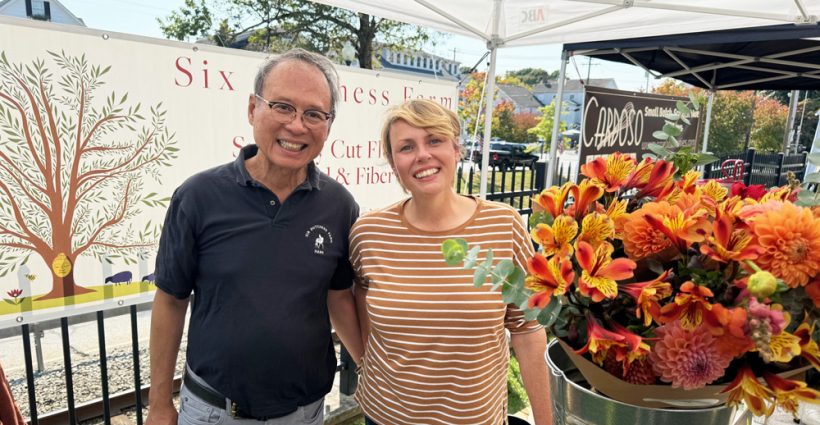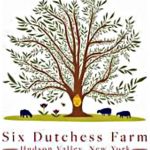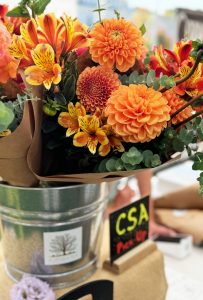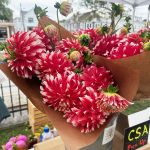designed for the way women work.

What Flower Farmers Can Teach Us About Giving Back by Dorian Winslow
Category: Presenting "The Curious Gardener"
 I met Jennifer and her husband Hans of Six Dutchess Farm at our local Pawling Farmers Market in the Hudson Valley, NY. On display, and for sale, are some of the most gorgeous bunches of flowers I’ve ever seen. They also have a CSA pick up there every Saturday from June through September.
I met Jennifer and her husband Hans of Six Dutchess Farm at our local Pawling Farmers Market in the Hudson Valley, NY. On display, and for sale, are some of the most gorgeous bunches of flowers I’ve ever seen. They also have a CSA pick up there every Saturday from June through September.
What’s also on display, but not as visible, is the farming ethos they practice. Call it regenerative or restorative agriculture, where you give back more to the land than you take. The idea is that the connective tissue between the flowers, the pollinators, the animals that graze near by and the soil is what your farm thrives on. It’s not a byproduct, it is the product.
They came to farming by accident, both having grown up in cities (she in NYC and he in Hong Kong). Jennifer worked in international humanitarian aid for the UN, and Hans is an architect. Their 12-acre property in Dutchess County was a weekend getaway, and they lived in NYC during the week.
Seven years ago they decided, for a variety of reasons, some of which seemed at the time like divine intervention, to move fulltime to the country and turn their passion into their livelihood. They are just 70 miles north of NYC, but “It feels like a world away,” says Jennifer.
“Once you get your hands in the soil, it’s hard to leave,” Jennifer says about the decision to become fulltime farmers.
But the land needed a rest. They had been boarding up to 12 horses at a time, and horses are hard on the land. Plus, Jennifer is allergic to them.
When you talk to Jennifer, you get the feeling she and her husband do nothing half way. They took courses in sustainable farming at Stone Barns in Westchester County and at Ballymaloe in Ireland, and learned flower farming through an intensive virtual course taught by Erin Benzakein of Floret Flower Farm in Washington State.
They decided to raise Gotland sheep for fiber (sheep are gentler on the land than horses), and heritage chickens for eggs. They brought in honeybees to pollinate the fruit orchard, which had never produced fruit for as long as Jennifer and Hans had lived there.
About 4 years ago, they added their first high tunnel for cut flower growing. They added 2 more in 2023, and they just received a USDA grant in 2024 to erect a brand new huge (30’ x 96’) tunnel to extend the growing season. “There was a big learning curve when we started growing flowers in tunnels,” says Jennifer. “The first year was a disaster because we had only one small 16’ x 50’ tunnel and it was a very hot and humid summer,” and the dahlias they planted did not respond well. Since then, they have found which flowers respond best to tunnel growing, and it has changed the way they grow flowers for the better, increasing the output and quality. Certain flowers they grow, such as lisianthus and Icelandic poppies, seem to do much better in tunnels, where they are protected from excessive rainfall and wet weather.
Here’s a list of the flowers Six Dutchess Farm grows:
- Early season (Spring): Field Tulips (crop failures in Holland the past 2 years have caused bulb prices to skyrocket), anemones, ranunculus, Icelandic poppies, hellebores, daffodils, peonies and bearded Irises.
- Mid-season (Summer): Campanula, field perennials for summertime, snapdragons, lilies, alstroemeria, veronica, verbena, china asters, and over 3 dozen varieties of lisianthus.
- Late season (Fall): Dahlias, eucalyptus, heirloom chrysanthemum.
- Off-Season (Wintertime): They also sell winter tulips, which are rooted and forced indoors, and early-winter blooming paperwhites and jumbo amaryllis.
“Our strategy is to grow more specialty type flowers that are harder to grow,” says Jennifer. It helps insulate them from competition. At the three farmers markets where they sell, occasionally other farms selling primarily produce will bring bunches of zinnias and sunflowers, too, but Six Dutchess is the only one offering lisianthus, ranunculus, campanula, and other specialty flowers!
In addition to tunnel-growing, they rotate crops around their farm each season and cover crop many beds in between plantings. For example, they sow mustard as a cover crop for the lisianthus beds. They also try to minimize disturbance to the land, which means working with the natural landscape to find ideal places to build new planting beds. Because it’s a hilly piece of land with graceful natural slopes, they have carved out multiple planting areas where they can find flat land. They grow on approximately 2 acres of their 12-acre farm. Soil health is a priority.
“The soil needs to be healthy or problems will show up in the quality of the sheep fleeces or the quality of our flowers,” says Jennifer. They have a small flock of 6 sheep. If they stay in one pasture too long, it can create problems with parasites, so they rotate their sheep around the farm. “If anything is wrong, it will eventually show up in our products,” she says.
The way they have set up their farm business, they have 4 revenue streams: food, fiber, flowers and education. Each supports the whole. So, for instance, their small apiary of 16 hives produces honey and also pollinates the flowers and fruit trees. They have virtual classes in knitting and cooking, and in the future maybe in growing flowers (fingers crossed!)
I asked Jennifer about my own cutting garden, which is a 48’ x 36’ area I fenced in for growing annual flowers. It was everything I hoped for in the end, but I picked up some good tips from Jennifer. It should be noted that I grew the easier-to-grow flowers, staying away from the specialty type flowers grown at Six Dutchess (except dahlias). My list: zinnias, dahlias, sunflowers, gomphrena, salvia, verbena, strawflowers and scabiosa. I had the most success with zinnias, dahlias and gomphrena.
Tips I Learned from Six Dutchess Farm:
- Staking– Provide adequate staking for taller flowers. It’s heartbreaking when they fall over and their stems break from the weight of the flowers. If you have rows of flowers, you can purchase stakes and netting. The flowers grow up and through the netting. You can add another layer of netting at the top later in the season, if necessary. If you are planting in a garden bed (not for production), plant flowers in communities so they can lean on each other and provide support.
- Growing from seed indoors or buying plants– The best way to minimize transmission of disease is to sow from seed indoors or buy plugs from a nursery. Sowing seeds directly into the ground can be riskier. Be sure to buy from a reputable seed company or nursery in the case of plugs.
- Powdery Mildew– Certain flowers, like Zinnias, Cosmos, Sunflowers, are really prone to powdery mildew, probably because they are grown in very close proximity. Often times, when we take all precautions, but still find mildew, we just deal with it and make the best out of a natural occurrence. When making flower arrangements, strip off the leaves, so mildew is no longer visible. Only in the very worst cases will it impact the flowers themselves. It is primarily present on stems and leaves. Keep thinning out the beds, deadhead, harvest regularly and focus on good airflow.
- At the end of the season — The best way to give back to the soil is to let microbes do their work, undisturbed. At the end of the growing season try not to pull plant roots out, unless they are weeds, other undesirables, or diseased roots. Cut plants at the base and leave roots intact for the winter. If annuals, we try to rotate on a 4-year cycle to prevent disease or pest pressure build-up. We also test our soil every fall, and send samples out to a local lab, to see how to amend our beds, as needed, for optimal growth. Always make sure to remove diseased plant matter and, if growing delicate perennials or dealing with large areas of uncovered soil, provide a natural mulch for protection.
Learn more about Six Dutchess Farm at https://www.sixdutchessfarm.com. Follow on Instagram @sixdutchessfarm.


